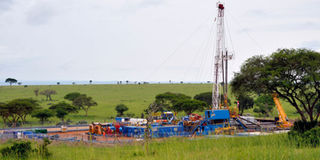Prime
Uganda’s oil reserves: How much are recoverable?

An oil rig in Buliisa District. Oil companies say first oil will flow 36 months after from Final Investment Decision whenever it is taken. FILE PHOTO
What you need to know:
By the end of 2006, following announcement of discovery of commercial oil finds in October of that year, Uganda’s oil reserves averaged at 300 million barrels. The oil finds expanded to 3.5 billion barrels in 2012 and currently are estimated at 6.5 billion barrels, but of which only 1 billion barrels are recoverable under the prevailing conditions, writes Frederic Musisi.
It emerged recently that during ongoing negotiations for the proposed East Africa Crude Oil Pipeline (EACOP), recoverable oil volumes now stand at 1 billion barrels instead of the estimates of between 1.4 billion and 1.7 billion barrels that officials previously quoted.
Recoverable oil is the proportion oil that can be technically and economically possible to extract from the ground. The recoverable 1 billion barrels is out of the total reserves of 6.5 billion barrels.
Reserves are quantities of oil and gas anticipated to be commercially produced, from known accumulations, by applying available technology to develop the projects from a given date under defined conditions.
The revelation, first made by this newspaper, sparked consternation and bewilderment alike; in some circles, particularly on social media. It was said that the oil had “disappeared” as it is often claimed that government is furtively shipping out oil through tankers.
Officials familiar with the matter told this newspaper, then, that the estimate of 1 billion barrels are merely a working figure for the pipeline negotiations for determination of among other things, the transit tariff whose assessment—real versus nominal—remains a sticking issue.
Oil reserve estimates
According to the Petroleum Authority of Uganda (PAU), the industry regulator, Uganda’s oil reserve estimates remain 6 billion barrels and the estimates of 1 billion barrels is the recoverable volumes at the “current conditions.”
“These reserves can be increased to 1.4 billion barrels from contingent resources,” said Gloria Sebikari, PAU’s manager for corporate affairs and public relations.
Contingent resources, according to PAU, are quantities of oil and gas estimated to be potentially recoverable, but currently not considered to be commercially recoverable due to one or more contingencies.
Contingent resources may include; projects where the field development plans have not yet been approved, where commercial recovery is dependent on technology under development, where data is insufficient to clearly assess commerciality, or where regulatory or social acceptance concerns may exist.
Production licences
The ministry of Energy has so far granted nine production licences for 14 fields which means they are as good as ready for oil production.
According to PAU, nine of the 14 fields are planned to early commercial oil production, or first oil, which the government is upbeat about. The nine fields are Ngiri, Jobi-Rii, Gunya, Kasamene-Wahrindi, Kigogole-Nsoga under the Tilenga project operated by French Total E&P and Kingfisher operated by China’s Cnooc.
Volumes
In terms of production volumes, the Ngiri field is expected to produce about 50,000 barrels per day (kbpd): Jobi-Rii 70,000kbpd: Kasamene 20,000 kbpd: Wahirindi 3,250kbpd: Kigogole 20,000kbpd: and Nsoga 20,000kbpd.
The remaining five fields, Ngara expected to produce 750kbpd: Ngege 3,250kbpd: Mputa 4,500 kbpd: Nzizi 300kbpd, and 9 million cubic feet of gas: and Waraga 4,500kbpd, are planned for production in the subsequent years—between five and eight years, from the first commercial production cycle.
“The planned lifecycle for production of the estimated reserves from the Kingfisher and Tilenga projects is 25 years. This is expected to be prolonged when some of the current contingent resources become reserves,” PAU told Daily Monitor in an email.
“It is important to note that the reported resources depend on the interpretation of the available data and the technology for extraction, which is existing at the time and therefore often change when more data becomes available.”
PAU says over 60 percent acreage of Uganda’s oil belt—the Albertine Graben—that stretches from West Nile to South Western Uganda, has not undergone exploration, raising prospects of country’s oil reserves being larger.
“Attempts have been made to come up with resource estimates for the different prospects within these unlicensed areas. However, these are always not reported since the prospects have not yet been drilled. Therefore, the resources have not been discovered.”
Uganda also has gas reserves estimated about 500 billion cubic feet which will also be produced.
In addition to the Albertine Graben, the ministry of Energy through the Directorate of Petroleum, is currently studying other areas—the Moroto-Kadam basin, the Lake Victoria basin, Lake Kyoga basin, and Lake Wamala basin for oil and gas prospects.
In estimating the country’s oil and gas reserves, PAU says it uses the “most recognised industry guidelines for reporting petroleum resources called the Society of Petroleum Engineers - Petroleum Resource Management System (SPE-PRMS)”.
This system was developed and is managed by the following four international professional institutions: The Society of Petroleum Engineers, the American Association of Petroleum Geologists the World Petroleum Council; and the Society of Petroleum Evaluation Engineers. An elected committee of professionals from the four institutions above provides regular updates on the system which are continuously reported by the SPE.
“Uganda’s petroleum resources are classified in accordance with SPE-PRMS as reserves, contingent resources and prospective resources. The resources documented for Uganda include both the discovered (reserves and contingent resources) and undiscovered (prospective) resources,” PAU added.
“The petroleum resource estimates for the country are generated based on the PAU’s assessment using the available data and harmonisation with the resource reports submitted by the licensees.”
In effect, the volumes of 1 billion reserves can be said to be ready for production once the oil companies—Total E&P, and Cnooc, reach Final Investment Decision (FID), expected by October.




